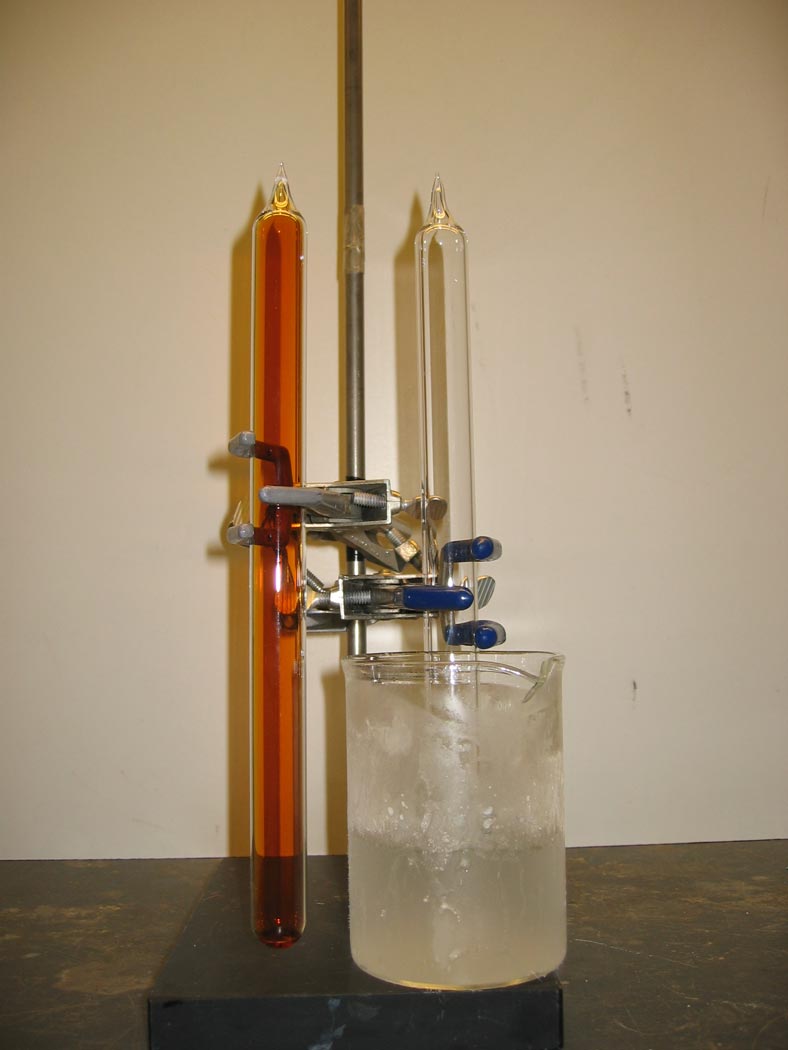The skies of Los Angeles: Gas phase equilibria and the chemistry of "smog"
 A sealed tube containing "smog" is cooled. The smog magically disappears.
A sealed tube containing "smog" is cooled. The smog magically disappears.
Ingredients: sealed tubes of nitrogen dioxide gas
Procedure: A complete recipe follows.
1. Take two sealed tubes containing excess liquid nitrogen dioxide.
2. Leave one tube at room temperature, while placing the second tube in an ice water bath.
3. Observe the changes in the color of the gases within the tube.
Understanding: The reddish-brown nitrogen dioxide gas has a melting point of -11.2C (11.8F) and a boiling point of 21.1C (70.0F). Atmospheric nitrogen dioxide is the principal colorant of reddish-brown smog that famously colors the skies of Los Angeles.
In the sealed tube, molecules of nitrogen dioxide, NO2, are constantly colliding with each other, at times leading to the formation of dinitrogen tetroxide, N2O4. The dinitrogen tetroxide molecules also undergo collisions, at times leading to their decomposition into two molecules of nitrogen dioxide.
2 NO2(g) → N2O4(g)
At higher temperatures, the reaction favors the formation of more disorder or entropy, through the formation of more NO2 molecules. At lower temperatures, the reaction favors species of lower energy through the formation of more N2O4 molecules. This chemical equilibrium provides a lovely example of the two principal driving forces in reaction chemistry - the drive to lower energy and favorable atomic interactions, and the drive to increase entropy and atomic disorder.In the atmosphere, most nitrogen dioxide is produced in the cylinders of car engines. Carburetors mix air, containing nitrogen and oxygen, with gasoline hydrocarbons. The mixture is compressed, by pistons, and ignited, by spark plugs, at high temperature and pressure in the engine's cylinders. The result is a combustion reaction that forms carbon dioxide and water, but also nitric oxide, NO, and nitrogen dioxide, NO2. The nitrogen oxides produced in the automobile emissions react with atmospheric oxygen to produce additional nitrogen dioxide, nitrogen trioxide, and dinitrogen pentoxide gases.
A direct pathway for the formation of acid rain is the dissolution of nitrogen dioxide in the water droplets of clouds, followed by the chemical reaction of nitrogen dioxide with water to produce nitrous acid, HNO2, and nitric acid, HNO3.
2 NO2(g) + H2O(l) → HNO2(aq) + HNO3(aq)
Additional reactions of the nitrogen oxides lead to the formation of a variety of biological irritants in addition to nitric and nitrous acids, including peroxynitric acid, HO2NO2.The molecular structure of smog
Question: Draw the Lewis structures for nitric oxide, dinitrogen oxide (nitrous oxide), nitrogen dioxide, dinitrogen tetroxide, dinitrogen pentoxide, nitrous acid, nitric acid and peroxynitric acid.You can check your answers here.
You can check your answers here.
Clear skies
Question:
Will clear skies on a cold day in Los Angeles necessarily indicate a reduction in atmospheric smog and the potential for the production of acid rain?